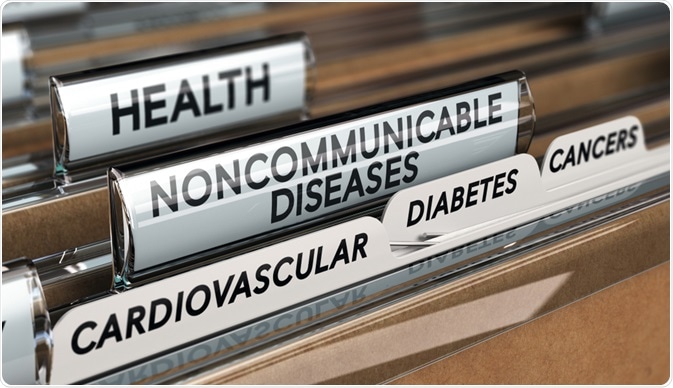Non-communicable diseases (NCD) are defined by The World Health Organization (WHO) as chronic conditions, usually of long duration, and caused by a combination of genetic, physiological, environmental, and behavioral factors. These diseases are not infectious and tend to have a more significant impact on lower to middle-income countries due to the influence of environmental and behavioral factors.
Image Credit: Olivier Le Moal/Shutterstock.com
Non-communicable disease and global health
Cardiovascular diseases such as heart attacks and stroke, diabetes, chronic respiratory diseases such as asthma, and a wide range of cancers are the main types of NCD that impact the world’s population today.
Annually and around the globe, over 41 million people die from NCDs, accounting for 71% of all deaths each year. Additionally, statistics reveal that 15 million people between the ages of 30 and 69 die each year from NCDs, with 85% of these deaths deemed ‘premature’ occurring in low- and middle-income countries. This demonstrates the significant socio-economic influence over the development and progression of this disease.
In terms of which NCDs are most prevalent, cardiovascular diseases are the most common, with 17.9 million people dying annually. Cancer claims the following most significant proportion of lives (9.3 million), followed by respiratory diseases (4.1 million), and finally, diabetes (1.5 million). In total, these four groups of diseases account for over 80% of all NCD-related premature deaths.
Studies have shown that a combination of genetic, physiological, environmental, and behavioral factors are involved in the development and progression of NCDs. In particular, tobacco use and harmful use of alcohol, physical inactivity, and unhealthy diets increase a person’s risk of dying from an NCD.
Global health organizations have identified effective methods of diagnosis, screening, and treatment as the critical components in responding to this condition in addition to palliative care.
Noncommunicable Diseases and their Risk Factors (animated video)
Risk factors of non-communicable diseases
NCDs affect people of all ages and are a significant burden for all countries and regions, although evidence shows that some groups are more at risk than others. Studies show that those in older age groups are more likely to die from NCDs. However, the disease still significantly impacts younger age groups, with 15 million deaths aged 30 to 69 attributed to NCDs.
Additionally, data shows that the burden of NCDs is more pronounced in particular global regions, with ‘premature’ deaths of those in younger age groups more likely to occur in parts of developing parts of the world.
Additionally, the risk factors that increase a person’s chances of developing and dying from an NCD impact all age groups without discrimination. Meaning that harmful behaviors, such as poor diets or physical inactivity, influence disease progression in children, adults, and the elderly.
Certain factors have been identified as driving the prevalence of NCDs, including rapid and unplanned urbanization, the globalization of unhealthy lifestyles, and the increasing life expectancy of the population. Risk factors that influence NCDs can be categorized as modifiable behavioral risks and metabolic factors. The first group of factors can be addressed by stopping or changing a harmful behavior. The second are harder to manage due to physiological constructs, often associated with genetic factors.
Modifiable behavioral risk factors include exposure to tobacco (both smoking and passive smoking), physical inactivity (which can result in an elevation in blood pressure, blood glucose, blood lipids, and obesity), unhealthy diet, and harmful alcohol use. These risk factors have all been proven to increase a person’s risk of NCDs. For example, each year, tobacco (both smoking and second-hand smoking) is attributed to 7.2 million deaths and is predicted to continue to rise.
Unhealthy diets, mainly excessive sodium intake, are attributed to 4.1 million deaths each year. Over half of the total 3.3 million deaths linked with alcohol use are from NCDs. Finally, insufficient physical activity is attributed to 1.6 million deaths each year.
Metabolic risk factors, however, cannot be directly manipulated in the way that behavioral factors can, although, with the right strategies, alteration is possible. Metabolic risk factors include elevated blood pressure, obesity, hyperglycemia, and hyperlipidemia. These metabolic risk factors can result from behavioral factors but are also moderated by genetic factors. Data shows that the leading metabolic risk factor is increased blood pressure, with 19% of global deaths from NCDs attributed to this factor.
The way forward to reducing the prevalence of NCDs may be in establishing effective preventative methods that lower these risk factors.
While innovations in diagnostics and therapeutics are undoubtedly vital to improving outcomes and lowering deaths, preventive approaches are essential because the risk factors involved in these diseases, such as modifiable behavioral risk factors, are changeable. Knowledge of how to induce effective and long-term change in these behaviors will likely be fundamental to reducing the prevalence of NCDs.
References
Further Reading
Last Updated: Aug 9, 2021